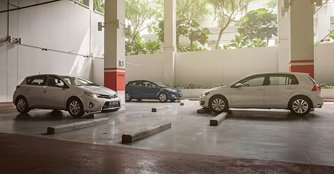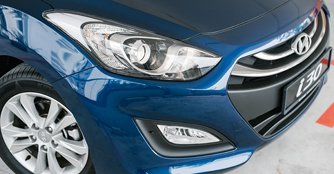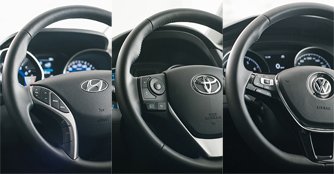Hyundai i30 1.6 (A) Toyota Auris 1.6 (A) vs Volkswagen Golf 1.4 TSI DSG (A)
05 Jul 2013|62,453 views
The Golf is an icon. The renowned name in the automotive world is like a celebrity among a crowd of newcomers. It has enjoyed decades of stardom, thanks to its down-to-earth image, which is likeable and easy to fall for. The figures, perhaps, tell it all - seven generations, 30 million copies, and still counting.
Unlike the Golf, the Auris is merely in its first incarnation in Singapore. That however, should not be its weakness. There is no doubt about the Japanese's car building capabilities, and the Auris marks a fresh, brand new approach to the family hatchback segment.
Similarly, the i30 was a departure for Hyundai. Following its recent revamp to move upclass, the hatchback is more continental - in both the way it looks and feel.
These three hatchbacks couldn't have been more different in the way they were conceived, designed, and constructed. And it is no surprise that the two newcomers came with the Golf's throne in mind. But will they succeed?
Exterior
It is hard not to squint when it comes to telling the new Golf apart from its forebearer. Little has changed on its sheet metal, and although the latest is noticeably wider and longer, it retains the general proportions that makes it instantly recognisable as the hatchback icon.
On first look, it is almost difficult to tell that the Auris is a Toyota - which isn't a bad thing at all. The styling is fresh and invigorating, and it evokes a sense of dynamism - thanks to the crisply slit headlamps and angular front facet.
Unlike the Golf, the Auris is merely in its first incarnation in Singapore. That however, should not be its weakness. There is no doubt about the Japanese's car building capabilities, and the Auris marks a fresh, brand new approach to the family hatchback segment.
Similarly, the i30 was a departure for Hyundai. Following its recent revamp to move upclass, the hatchback is more continental - in both the way it looks and feel.
These three hatchbacks couldn't have been more different in the way they were conceived, designed, and constructed. And it is no surprise that the two newcomers came with the Golf's throne in mind. But will they succeed?
Exterior
It is hard not to squint when it comes to telling the new Golf apart from its forebearer. Little has changed on its sheet metal, and although the latest is noticeably wider and longer, it retains the general proportions that makes it instantly recognisable as the hatchback icon.
On first look, it is almost difficult to tell that the Auris is a Toyota - which isn't a bad thing at all. The styling is fresh and invigorating, and it evokes a sense of dynamism - thanks to the crisply slit headlamps and angular front facet.
 |
On closer look the Auris carries a slight hint of the RAV4, especially the way the front and rear lamps are arranged. This brings about a strong sense of family identity, which has been inherent in most European car designs.
However, it is the i30's looks that bought us over. The housed headlamps with chrome in-sills feel elaborated but not overtly complicating. Credits, too, need to be paid to the fluid sweeping lines, which nicely decorates the front facet and wraps around the body.
As a whole, the Golf feels mature while Auris is dynamic, but we reckon the Hyundai's contemporary styling is the easiest to fall for.
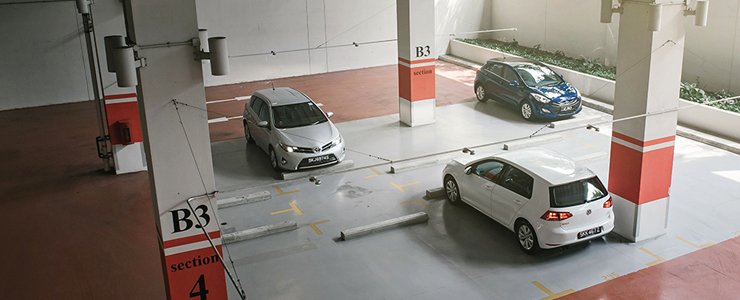 |
Interior
The i30 gets the worthy mention first. We like what the designers have done with its interior, merging form with strong function. Controls for the entertainment system take centre stage, and is well laid out and easy to use, while a large cubby hole right beneath comes in handy for storing personal items on the move.
In comparison, the Auris' centre console looks slightly nerdy with its components laid in a 'straight up' manner. That said, it still aces in terms of functionality and ease of use. Like the i30 and Golf, the Auris borrows bits of its interior from its other siblings, such as the familiar-looking climate control switches, which were also found on the RAV4. Nevertheless, the Auris feels pleasant to be in.
The Golf's interior, on the other hand, feels relatively newer and sportier. The flat-bottomed steering with gloss black trims add joy to driving. This base model gets a slightly smaller multi-functional display (5.0-inch compared to 8.0-inch on the Sport variant), but is still fuss free to operate thanks to its touchscreen capability.
The i30 gets the worthy mention first. We like what the designers have done with its interior, merging form with strong function. Controls for the entertainment system take centre stage, and is well laid out and easy to use, while a large cubby hole right beneath comes in handy for storing personal items on the move.
In comparison, the Auris' centre console looks slightly nerdy with its components laid in a 'straight up' manner. That said, it still aces in terms of functionality and ease of use. Like the i30 and Golf, the Auris borrows bits of its interior from its other siblings, such as the familiar-looking climate control switches, which were also found on the RAV4. Nevertheless, the Auris feels pleasant to be in.
The Golf's interior, on the other hand, feels relatively newer and sportier. The flat-bottomed steering with gloss black trims add joy to driving. This base model gets a slightly smaller multi-functional display (5.0-inch compared to 8.0-inch on the Sport variant), but is still fuss free to operate thanks to its touchscreen capability.
Space wise, the new Golf's stretched wheelbase gives rise to generous cabin space - the biggest in this comparison. The leather upholstery feels soft and premium to the touch, and is genuinely comfortable to be in. The Golf also has the largest load lugging capability with 380 litres of boot for loots - the largest among the trio.

 The Golf has the most spacious rear quarters, and offers the largest load lugging space of 380 litres
The Golf has the most spacious rear quarters, and offers the largest load lugging space of 380 litres
The Auris, too, isn't short in this aspect. The raked rear bench provides a more relaxing ride than the others. The seats, too, have fabric centres, which adds contrast to the otherwise monotonous cabin - a nice touch that gives it a more lively feel. Boot space wise, the Auris' is the smallest with only 352 litres.
While there is nothing to shout about in the i30, it is the only car in the comparison to come with a panoramic sunroof - one that stretches all the way back to the rear quarters. Ambience is livened up and feels more airy, although the Korean hatch is the most cramp when fitting three adults at the back. That said, the i30 still packs a decently sized boot of 378 litres - only marginally smaller than the Golf's.

The Auris, too, isn't short in this aspect. The raked rear bench provides a more relaxing ride than the others. The seats, too, have fabric centres, which adds contrast to the otherwise monotonous cabin - a nice touch that gives it a more lively feel. Boot space wise, the Auris' is the smallest with only 352 litres.
While there is nothing to shout about in the i30, it is the only car in the comparison to come with a panoramic sunroof - one that stretches all the way back to the rear quarters. Ambience is livened up and feels more airy, although the Korean hatch is the most cramp when fitting three adults at the back. That said, the i30 still packs a decently sized boot of 378 litres - only marginally smaller than the Golf's.
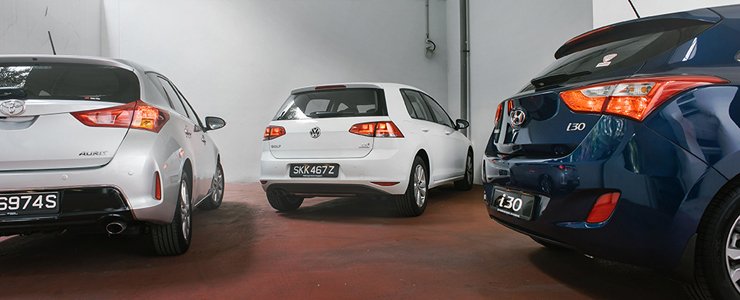 |
The Drive
While these hatchbacks aren't too far apart in the paper chase, they behave very differently on the road.
For starters, the Golf comes with a force-blown 1.4-litre engine, churning out 122 horses - the lowest rating in this comparison. In terms of straight line performance, however, the Golf's 200Nm of torque will see to a more sprightly acceleration.
The punchy engine of the Golf is further helped by the marque's DSG gearbox, which in its latest iteration, provides seamless swops through the ratios without losing engine power.
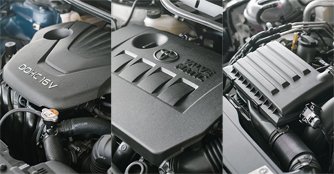
 The i30 (left) punches out 128bhp; The Auris (centre) triumphs the horsepower race with 132bhp; The Golf (right) with the least output at 122bhp
The i30 (left) punches out 128bhp; The Auris (centre) triumphs the horsepower race with 132bhp; The Golf (right) with the least output at 122bhp
The Golf's driving mode selection allows altering of steering and throttle response. Likewise, we prefer the heavier setting on the Golf, which gives it a sportier driving feel over the other two hatches.
Under the i30's hood is a 1.6-litre naturally aspirated unit churning out 128bhp and 157Nm of torque. Unlike the dual clutch in the Golf, the i30 comes with a more conventional six-speed automatic. Driven leisurely, the gearbox is creamily smooth and makes for very pleasant cruising. However, it can be slightly sluggish and less reactive when driven more enthusiastically.
The i30 also has three different steering modes which add/reduce weight of the steering. While the heavier settings make for a better drive, it does with little feedback from the road.
Similar to the i30, the Auris utilises a 1.6-litre unit. Operating under normal atmospheric pressure, the plant has the highest power rating in the group - 132bhp - and is coupled to a CVT gearbox for power transfer.
Like the i30, the Auris' CVT shifts imperceptibly when driven sensibly, providing a delectably smooth journey for the occupant. For the driver though, the lack of 'real shifting' takes a wee bit off in terms of driving involvement.
While these hatchbacks aren't too far apart in the paper chase, they behave very differently on the road.
For starters, the Golf comes with a force-blown 1.4-litre engine, churning out 122 horses - the lowest rating in this comparison. In terms of straight line performance, however, the Golf's 200Nm of torque will see to a more sprightly acceleration.
The punchy engine of the Golf is further helped by the marque's DSG gearbox, which in its latest iteration, provides seamless swops through the ratios without losing engine power.

The Golf's driving mode selection allows altering of steering and throttle response. Likewise, we prefer the heavier setting on the Golf, which gives it a sportier driving feel over the other two hatches.
Under the i30's hood is a 1.6-litre naturally aspirated unit churning out 128bhp and 157Nm of torque. Unlike the dual clutch in the Golf, the i30 comes with a more conventional six-speed automatic. Driven leisurely, the gearbox is creamily smooth and makes for very pleasant cruising. However, it can be slightly sluggish and less reactive when driven more enthusiastically.
The i30 also has three different steering modes which add/reduce weight of the steering. While the heavier settings make for a better drive, it does with little feedback from the road.
Similar to the i30, the Auris utilises a 1.6-litre unit. Operating under normal atmospheric pressure, the plant has the highest power rating in the group - 132bhp - and is coupled to a CVT gearbox for power transfer.
Like the i30, the Auris' CVT shifts imperceptibly when driven sensibly, providing a delectably smooth journey for the occupant. For the driver though, the lack of 'real shifting' takes a wee bit off in terms of driving involvement.
On the move, the Auris is light on its feet, and feels agile through tighter corners. The downside to this, however, is that it lacks the 'planted' feel of the i30 at higher speeds.
Running costs have always been an important attribute for sensible motoring choices - like the trio of family hatchbacks we have here. Most noteworthy is that the Koreans have upped their game in this aspect. The i30 managed 12.5km/L, very close to the Auris' 12.6km/L and 12.9km/L on the Golf.
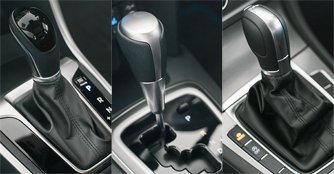
 Golf's DSG (right) is easily the most enjoyable to work with; Auris' CVT (centre) is smooth but least engaging; i30's six-speeder (left) can be slow to react
Golf's DSG (right) is easily the most enjoyable to work with; Auris' CVT (centre) is smooth but least engaging; i30's six-speeder (left) can be slow to react
Conclusion
There are no doubts that the Korean's and Japanese's take on the segment are competent in their own ways.
The Koreans, more notably, have advanced greatly in the field of automotive, and the i30 builds on with better efficiency and design. Still, better selection of material would have made the car a more compelling choice.
One of the Auris' best trait lies in its fuss free driving - one could simply hop in and drive off easily. Toyota had the Auris made in the U.K. to give it a more continental appeal - betting chips to go against the western makes.
While it was a very close fight, our bets still lie with the Golf. Not only is it a more complete package, the driver will be pleased with the dynamics and occupants with the spacious cabin. The Mk7 makes things a little sweeter by being more refined and competent than its forebearers.
Long live the icon.
Running costs have always been an important attribute for sensible motoring choices - like the trio of family hatchbacks we have here. Most noteworthy is that the Koreans have upped their game in this aspect. The i30 managed 12.5km/L, very close to the Auris' 12.6km/L and 12.9km/L on the Golf.

Conclusion
There are no doubts that the Korean's and Japanese's take on the segment are competent in their own ways.
The Koreans, more notably, have advanced greatly in the field of automotive, and the i30 builds on with better efficiency and design. Still, better selection of material would have made the car a more compelling choice.
One of the Auris' best trait lies in its fuss free driving - one could simply hop in and drive off easily. Toyota had the Auris made in the U.K. to give it a more continental appeal - betting chips to go against the western makes.
While it was a very close fight, our bets still lie with the Golf. Not only is it a more complete package, the driver will be pleased with the dynamics and occupants with the spacious cabin. The Mk7 makes things a little sweeter by being more refined and competent than its forebearers.
Long live the icon.
The Golf is an icon. The renowned name in the automotive world is like a celebrity among a crowd of newcomers. It has enjoyed decades of stardom, thanks to its down-to-earth image, which is likeable and easy to fall for. The figures, perhaps, tell it all - seven generations, 30 million copies, and still counting.
Unlike the Golf, the Auris is merely in its first incarnation in Singapore. That however, should not be its weakness. There is no doubt about the Japanese's car building capabilities, and the Auris marks a fresh, brand new approach to the family hatchback segment.
Similarly, the i30 was a departure for Hyundai. Following its recent revamp to move upclass, the hatchback is more continental - in both the way it looks and feel.
These three hatchbacks couldn't have been more different in the way they were conceived, designed, and constructed. And it is no surprise that the two newcomers came with the Golf's throne in mind. But will they succeed?Exterior
It is hard not to squint when it comes to telling the new Golf apart from its forebearer. Little has changed on its sheet metal, and although the latest is noticeably wider and longer, it retains the general proportions that makes it instantly recognisable as the hatchback icon.
On first look, it is almost difficult to tell that the Auris is a Toyota - which isn't a bad thing at all. The styling is fresh and invigorating, and it evokes a sense of dynamism - thanks to the crisply slit headlamps and angular front facet.
Unlike the Golf, the Auris is merely in its first incarnation in Singapore. That however, should not be its weakness. There is no doubt about the Japanese's car building capabilities, and the Auris marks a fresh, brand new approach to the family hatchback segment.
Similarly, the i30 was a departure for Hyundai. Following its recent revamp to move upclass, the hatchback is more continental - in both the way it looks and feel.
These three hatchbacks couldn't have been more different in the way they were conceived, designed, and constructed. And it is no surprise that the two newcomers came with the Golf's throne in mind. But will they succeed?Exterior
It is hard not to squint when it comes to telling the new Golf apart from its forebearer. Little has changed on its sheet metal, and although the latest is noticeably wider and longer, it retains the general proportions that makes it instantly recognisable as the hatchback icon.
On first look, it is almost difficult to tell that the Auris is a Toyota - which isn't a bad thing at all. The styling is fresh and invigorating, and it evokes a sense of dynamism - thanks to the crisply slit headlamps and angular front facet.
On closer look the Auris carries a slight hint of the RAV4, especially the way the front and rear lamps are arranged. This brings about a strong sense of family identity, which has been inherent in most European car designs.
However, it is the i30's looks that bought us over. The housed headlamps with chrome in-sills feel elaborated but not overtly complicating. Credits, too, need to be paid to the fluid sweeping lines, which nicely decorates the front facet and wraps around the body.
As a whole, the Golf feels mature while Auris is dynamic, but we reckon the Hyundai's contemporary styling is the easiest to fall for.
However, it is the i30's looks that bought us over. The housed headlamps with chrome in-sills feel elaborated but not overtly complicating. Credits, too, need to be paid to the fluid sweeping lines, which nicely decorates the front facet and wraps around the body.
As a whole, the Golf feels mature while Auris is dynamic, but we reckon the Hyundai's contemporary styling is the easiest to fall for.
Interior
The i30 gets the worthy mention first. We like what the designers have done with its interior, merging form with strong function. Controls for the entertainment system take centre stage, and is well laid out and easy to use, while a large cubby hole right beneath comes in handy for storing personal items on the move.
In comparison, the Auris' centre console looks slightly nerdy with its components laid in a 'straight up' manner. That said, it still aces in terms of functionality and ease of use. Like the i30 and Golf, the Auris borrows bits of its interior from its other siblings, such as the familiar-looking climate control switches, which were also found on the RAV4. Nevertheless, the Auris feels pleasant to be in.
The Golf's interior, on the other hand, feels relatively newer and sportier. The flat-bottomed steering with gloss black trims add joy to driving. This base model gets a slightly smaller multi-functional display (5.0-inch compared to 8.0-inch on the Sport variant), but is still fuss free to operate thanks to its touchscreen capability.
The i30 gets the worthy mention first. We like what the designers have done with its interior, merging form with strong function. Controls for the entertainment system take centre stage, and is well laid out and easy to use, while a large cubby hole right beneath comes in handy for storing personal items on the move.
In comparison, the Auris' centre console looks slightly nerdy with its components laid in a 'straight up' manner. That said, it still aces in terms of functionality and ease of use. Like the i30 and Golf, the Auris borrows bits of its interior from its other siblings, such as the familiar-looking climate control switches, which were also found on the RAV4. Nevertheless, the Auris feels pleasant to be in.
The Golf's interior, on the other hand, feels relatively newer and sportier. The flat-bottomed steering with gloss black trims add joy to driving. This base model gets a slightly smaller multi-functional display (5.0-inch compared to 8.0-inch on the Sport variant), but is still fuss free to operate thanks to its touchscreen capability.
Space wise, the new Golf's stretched wheelbase gives rise to generous cabin space - the biggest in this comparison. The leather upholstery feels soft and premium to the touch, and is genuinely comfortable to be in. The Golf also has the largest load lugging capability with 380 litres of boot for loots - the largest among the trio.
The Auris, too, isn't short in this aspect. The raked rear bench provides a more relaxing ride than the others. The seats, too, have fabric centres, which adds contrast to the otherwise monotonous cabin - a nice touch that gives it a more lively feel. Boot space wise, the Auris' is the smallest with only 352 litres.
While there is nothing to shout about in the i30, it is the only car in the comparison to come with a panoramic sunroof - one that stretches all the way back to the rear quarters. Ambience is livened up and feels more airy, although the Korean hatch is the most cramp when fitting three adults at the back. That said, the i30 still packs a decently sized boot of 378 litres - only marginally smaller than the Golf's.
The Auris, too, isn't short in this aspect. The raked rear bench provides a more relaxing ride than the others. The seats, too, have fabric centres, which adds contrast to the otherwise monotonous cabin - a nice touch that gives it a more lively feel. Boot space wise, the Auris' is the smallest with only 352 litres.
While there is nothing to shout about in the i30, it is the only car in the comparison to come with a panoramic sunroof - one that stretches all the way back to the rear quarters. Ambience is livened up and feels more airy, although the Korean hatch is the most cramp when fitting three adults at the back. That said, the i30 still packs a decently sized boot of 378 litres - only marginally smaller than the Golf's.
The Drive
While these hatchbacks aren't too far apart in the paper chase, they behave very differently on the road.
For starters, the Golf comes with a force-blown 1.4-litre engine, churning out 122 horses - the lowest rating in this comparison. In terms of straight line performance, however, the Golf's 200Nm of torque will see to a more sprightly acceleration.
The punchy engine of the Golf is further helped by the marque's DSG gearbox, which in its latest iteration, provides seamless swops through the ratios without losing engine power.
The Golf's driving mode selection allows altering of steering and throttle response. Likewise, we prefer the heavier setting on the Golf, which gives it a sportier driving feel over the other two hatches.
Under the i30's hood is a 1.6-litre naturally aspirated unit churning out 128bhp and 157Nm of torque. Unlike the dual clutch in the Golf, the i30 comes with a more conventional six-speed automatic. Driven leisurely, the gearbox is creamily smooth and makes for very pleasant cruising. However, it can be slightly sluggish and less reactive when driven more enthusiastically.
The i30 also has three different steering modes which add/reduce weight of the steering. While the heavier settings make for a better drive, it does with little feedback from the road.
Similar to the i30, the Auris utilises a 1.6-litre unit. Operating under normal atmospheric pressure, the plant has the highest power rating in the group - 132bhp - and is coupled to a CVT gearbox for power transfer.
Like the i30, the Auris' CVT shifts imperceptibly when driven sensibly, providing a delectably smooth journey for the occupant. For the driver though, the lack of 'real shifting' takes a wee bit off in terms of driving involvement.
While these hatchbacks aren't too far apart in the paper chase, they behave very differently on the road.
For starters, the Golf comes with a force-blown 1.4-litre engine, churning out 122 horses - the lowest rating in this comparison. In terms of straight line performance, however, the Golf's 200Nm of torque will see to a more sprightly acceleration.
The punchy engine of the Golf is further helped by the marque's DSG gearbox, which in its latest iteration, provides seamless swops through the ratios without losing engine power.
The Golf's driving mode selection allows altering of steering and throttle response. Likewise, we prefer the heavier setting on the Golf, which gives it a sportier driving feel over the other two hatches.
Under the i30's hood is a 1.6-litre naturally aspirated unit churning out 128bhp and 157Nm of torque. Unlike the dual clutch in the Golf, the i30 comes with a more conventional six-speed automatic. Driven leisurely, the gearbox is creamily smooth and makes for very pleasant cruising. However, it can be slightly sluggish and less reactive when driven more enthusiastically.
The i30 also has three different steering modes which add/reduce weight of the steering. While the heavier settings make for a better drive, it does with little feedback from the road.
Similar to the i30, the Auris utilises a 1.6-litre unit. Operating under normal atmospheric pressure, the plant has the highest power rating in the group - 132bhp - and is coupled to a CVT gearbox for power transfer.
Like the i30, the Auris' CVT shifts imperceptibly when driven sensibly, providing a delectably smooth journey for the occupant. For the driver though, the lack of 'real shifting' takes a wee bit off in terms of driving involvement.
On the move, the Auris is light on its feet, and feels agile through tighter corners. The downside to this, however, is that it lacks the 'planted' feel of the i30 at higher speeds.
Running costs have always been an important attribute for sensible motoring choices - like the trio of family hatchbacks we have here. Most noteworthy is that the Koreans have upped their game in this aspect. The i30 managed 12.5km/L, very close to the Auris' 12.6km/L and 12.9km/L on the Golf.
Conclusion
There are no doubts that the Korean's and Japanese's take on the segment are competent in their own ways.
The Koreans, more notably, have advanced greatly in the field of automotive, and the i30 builds on with better efficiency and design. Still, better selection of material would have made the car a more compelling choice.
One of the Auris' best trait lies in its fuss free driving - one could simply hop in and drive off easily. Toyota had the Auris made in the U.K. to give it a more continental appeal - betting chips to go against the western makes.
While it was a very close fight, our bets still lie with the Golf. Not only is it a more complete package, the driver will be pleased with the dynamics and occupants with the spacious cabin. The Mk7 makes things a little sweeter by being more refined and competent than its forebearers.
Long live the icon.
Running costs have always been an important attribute for sensible motoring choices - like the trio of family hatchbacks we have here. Most noteworthy is that the Koreans have upped their game in this aspect. The i30 managed 12.5km/L, very close to the Auris' 12.6km/L and 12.9km/L on the Golf.
Conclusion
There are no doubts that the Korean's and Japanese's take on the segment are competent in their own ways.
The Koreans, more notably, have advanced greatly in the field of automotive, and the i30 builds on with better efficiency and design. Still, better selection of material would have made the car a more compelling choice.
One of the Auris' best trait lies in its fuss free driving - one could simply hop in and drive off easily. Toyota had the Auris made in the U.K. to give it a more continental appeal - betting chips to go against the western makes.
While it was a very close fight, our bets still lie with the Golf. Not only is it a more complete package, the driver will be pleased with the dynamics and occupants with the spacious cabin. The Mk7 makes things a little sweeter by being more refined and competent than its forebearers.
Long live the icon.
Car Information
Hyundai i30 1.6 (A)
CAT B|Petrol|14.7km/L
Horsepower
97kW (130 bhp)
Torque
157 Nm
Acceleration
-
This model is no longer being sold by local distributor
All Used Hyundai i30Volkswagen Golf 1.4 TSI DSG (A)
CAT A|Petrol|20km/L
Horsepower
90kW (121 bhp)
Torque
200 Nm
Acceleration
9.3sec (0-100km /hr)
This model is no longer being sold by local distributor
All Used Volkswagen GolfToyota Auris 1.6 (A)
CAT A|Petrol|17.5km/L
Horsepower
97kW (130 bhp)
Torque
160 Nm
Acceleration
11.1sec (0-100km /hr)
This model is no longer being sold by local distributor
All Used Toyota AurisThank You For Your Subscription.

















































